Imagine stepping into a dining room that seamlessly blends the beauty of nature with sleek modern design—that’s the allure of organic modern dining spaces. This style has gained immense popularity for its calming, earthy vibe that creates an inviting atmosphere for gatherings and everyday meals alike.
In this article, you’ll find a variety of inspiring ideas to elevate your dining area with organic modern aesthetics. From warm wood accents to lush plant integrations, each concept offers a unique way to bring elegance and tranquility into your home, whether your space is cozy or spacious. Get ready to explore designs that celebrate natural materials and minimalist elegance!
1. Warm Wood Tones Paired with Neutral Textures for Cozy Sophistication

Ever feel like your dining space lacks that inviting, warm vibe that makes guests want to linger? Many modern rooms can look sleek but end up feeling cold or sterile. The secret to cozy sophistication often lies in how you balance natural elements and textures. You want a space that feels both refined and welcoming without overdoing it.
Imagine a dining area with rich oak or walnut furniture, their warm hues contrasting softly with plush, neutral-toned textiles. The chairs are upholstered in a creamy linen, and a chunky-knit throw drapes casually over the back. The subtle grain of wood brings natural texture, while the soft fabrics invite touch. Warm lighting enhances the earthy palette, making the room glow with understated elegance.
This look adapts easily from a rustic farmhouse style to a sleek contemporary vibe by swapping out textiles or wood finishes. For a more seasonal feel, add cozy wool throws in winter or lightweight cottons in summer. You can also incorporate darker woods or light-colored fabrics depending on your taste and the room’s lighting. Even small spaces benefit from this combination by choosing scaled-down furniture.
Start with selecting a solid wood table in a warm tone like cherry or teak. Pair it with upholstered chairs in neutral tones such as beige, taupe, or soft gray. Layer in textures with linen or hemp curtains and plush seat cushions for comfort. Use natural fiber rugs beneath the table to anchor the space. Finish with soft lighting, like warm LED fixtures or candle sconces, to create a cozy ambiance.
Add personal touches by choosing textiles with subtle patterns or handcrafted details. Incorporate a collection of vintage ceramic dishes or woven placemats that complement the earthy theme. Personalize with a mix of textures—smooth ceramics, rough wood, soft textiles—to keep the eye engaged. Small decorative items like carved wooden bowls or fabric-wrapped candles can elevate the look.
This approach proves that natural tones and textures never go out of style. It creates an inviting space perfect for both casual family dinners and elegant gatherings. With a little effort, you can craft a dining room that feels like a warm hug—simple, authentic, and timeless.
2. Minimalist White and Beige Palette with Sleek Modern Lines

Does your dining room feel cluttered or dull despite your best efforts? A minimalist approach might be just what you need to create a space that’s both clean and calming. White and beige palettes are known for their ability to make rooms appear larger and more open, but they can also feel cold without the right balance.
Visualize a dining table with a crisp white surface, its sleek edges floating above a soft beige rug. The chairs are streamlined, with slim metal legs and upholstered seats in matching neutral tones. Soft, indirect lighting highlights the simplicity of the design, casting gentle shadows that add depth. The space feels airy, organized, and effortlessly elegant, with every element serving a purpose.
This palette works well in both small and large spaces, and you can introduce subtle variations like matte or gloss finishes for added visual interest. In warmer climates, incorporate natural fibers or light wood accents to soften the look. During the holidays, add metallic or textured textiles for a festive touch. For a more eclectic style, mix modern furniture with vintage beige or white accessories.
Choose a sleek, rectangular or round white table with clean lines. Pair it with beige upholstered dining chairs or even transparent acrylic ones to maintain openness. Keep decor minimal—think of a simple centerpiece like a textured ceramic bowl or a set of neutral-toned candles. Use beige or off-white curtains and a matching wall paint to unify the space. Incorporate layered lighting with dimmable LED fixtures to enhance the mood.
Introduce subtle textures through woven placemats or a soft fabric runner in beige. Add interest with sculptural or geometric decor pieces in neutral tones. You might also include a statement lighting fixture above the table, like a sleek metal pendant or a modern chandelier, to add a focal point. Personal touches like handcrafted ceramic ware or unique tableware can make the space truly yours.
This minimalist style emphasizes simplicity and purpose, allowing your space to breathe. It encourages decluttering and intentional design, which can boost your mental clarity. With just a few carefully chosen pieces, you create a timeless dining room that’s as functional as it is beautiful.
3. Incorporating Natural Stone Elements for Subtle Rustic Charm
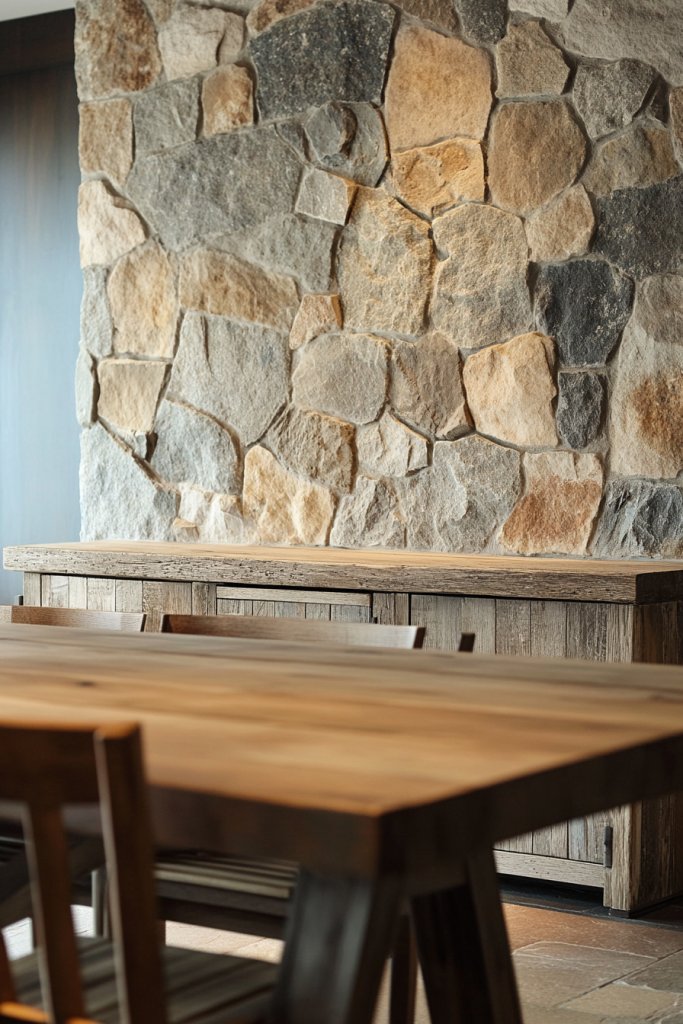
Ever wish your dining space had a touch of rustic charm without veering into overly country or rugged? Natural stone brings that earthy authenticity while maintaining elegance. It’s perfect for adding texture and grounding the room in nature, especially if you love a bit of rugged sophistication.
Envision a sturdy stone tabletop with natural veining and uneven edges, paired with wooden chairs that show the grain’s character. The stone’s tactile surface reflects light softly, adding depth without overwhelming the space. A textured stone accent wall behind the table creates a focal point, inviting touch and curiosity. Warm lighting accentuates the stone’s organic imperfections, making the room feel inviting.
Use different types of stones—limestone, slate, or granite—based on your aesthetic preference. For a more polished look, opt for smooth, honed surfaces; for rustic charm, leave the stone rough and natural. Combine with reclaimed wood furniture for a full rustic vibe or contrast with sleek modern pieces for an eclectic look. Seasonal accents like cozy textiles or metallic accessories can update the ambiance without clashing.
Select a stone slab or veneer that fits your space and style. Seal the surface properly to prevent staining, especially on tabletop surfaces. Pair the stone with wooden or metal supports, depending on the desired aesthetic. Incorporate textured stone or brick tiles on the wall for added interest. Keep lighting warm and subdued, such as wall sconces or hidden uplights, to enhance the natural textures.
Layer in soft textiles like burlap or linen for table runners and seat cushions. Add handcrafted ceramic or clay vessels to complement the stone’s earthy appeal. Incorporate vintage or artisanal metal accents to contrast textures. You can also carve or engrave personal motifs into the stone for a truly unique touch.
Using natural stone connects your space to the outdoors and evokes a sense of permanence. It’s a durable choice that ages well and gains character over time. This approach proves that rustic charm can be refined and sophisticated, creating a memorable dining experience for all who enter.
4. Floating Tables with Hidden Support for Sleek, Open Feel

Does your dining room feel cramped or cluttered, even if the furniture is modern? Floating tables can open up the space visually, creating an illusion of airiness and simplicity. They’re perfect for small rooms or those who crave a minimalist aesthetic but don’t want to sacrifice style.
Picture a sleek, rectangular table seemingly suspended in mid-air, supported by discreet hidden brackets or cantilevered supports. The tabletop is made of light-colored wood or stone, with smooth edges that blend seamlessly into the surroundings. Underneath, the floor remains visible, emphasizing the room’s openness. Ambient lighting highlights the floating effect, making the entire room feel spacious and modern.
Choose materials like glass, light wood, or composite surfaces for a contemporary look. The floating design suits both formal and casual dining spaces. You can also incorporate extendable or modular versions for flexibility. For a softer look, pair with plush, upholstered chairs or bench seating, keeping the overall feeling airy.
Start with a sturdy support structure hidden beneath the tabletop, such as reinforced brackets or steel supports. Use high-quality materials that can handle weight without sagging. Secure the support firmly to the wall or floor, ensuring safety and stability. Opt for a lightweight material for the tabletop to maximize the floating illusion. Finish with seamless edges and a smooth surface, and add indirect lighting underneath for the floating effect.
Enhance the look with textured or patterned tabletops, or add a subtle inlay or edge detail. Use cushions or upholstered sides to soften the space if desired. Incorporate a unique support design, such as sculptural metal or wood supports, to serve as a focal point. Play with color contrasts or finishes to match your style.
Floating tables redefine modern elegance by combining function and form seamlessly. They make your space appear larger and less cluttered, boosting your confidence in minimalist design. With careful planning, you can achieve a sophisticated, open feel that’s both practical and stunning.
5. Layered Rugs in Earthy Tones for Visual Depth and Comfort

Does your dining area lack warmth or seem flat, no matter how much you try? Layered rugs can add depth, texture, and a cozy vibe that transforms the space. They’re perfect for creating a multi-dimensional look that invites both the eyes and the feet to relax.
Visualize a large, plush rug in warm beige or taupe covering the floor, with a smaller, textured runner layered on top. The layered effect introduces different textures—soft wool, jute, or braided fibers—that add tactile richness. The rugs’ patterns and pile heights create visual interest, while the earthy tones ground the space. Ambient light bounces off the textured surfaces, giving the room a layered depth.
Combine flat-woven rugs with shaggy or looped pile for contrast. Use natural fibers like jute or hemp for an eco-friendly touch. Change the layering for seasons—thicker, warmer textiles in winter, lighter ones in summer. This technique also works in various room sizes, from compact apartments to large open-plan dining areas.
Start with a large, neutral base rug that anchors the space. Add a smaller, textured rug on top, positioning it to define the dining table area. Use non-slip pads underneath to keep rugs in place. Mix different textures and pile heights for a natural look, avoiding overly matching patterns. Keep color tones within the same palette for harmony. Clean regularly to maintain freshness and prevent slipping.
Layer with textiles like woven placemats, seat cushions, or throws that complement the rugs’ earthy palette. Incorporate subtle patterns or borders for added interest. Personalize further with artisanal or handcrafted rugs that tell a story. Add decorative elements like wooden or ceramic coasters to tie everything together.
Layered rugs are a simple yet powerful way to elevate your dining room’s style. They offer warmth, texture, and personality, making your space feel curated and unique. With these tricks, you can create a cozy, inviting environment perfect for any gathering.
6. Transparent or Light-Toned Seating to Maintain Open Sightlines
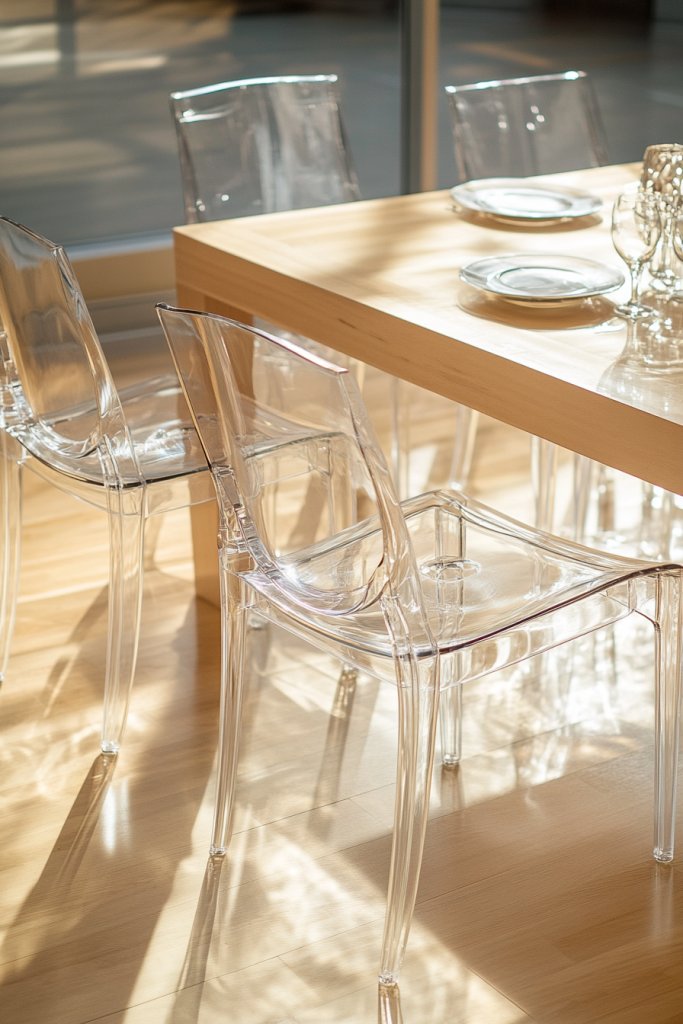
Feeling boxed in by bulky furniture? Clear or light-colored seating can make your dining area appear more spacious and airy. It’s a simple trick that transforms a cluttered look into a sleek, open environment perfect for modern organic design.
Picture a set of transparent acrylic chairs or light-toned upholstered seats with slim legs, arranged around a minimalist table. The chairs blend into the background, allowing your eye to focus on the textures and materials of the room rather than the furniture. The space feels less crowded, with sightlines unobstructed and natural light bouncing freely.
Choose from clear acrylic, glass, or light-colored fabrics like linen or cotton for a softer look. Mix and match different styles—perhaps a transparent chair paired with a wooden bench—to add visual interest without cluttering. This approach works especially well in small or narrow rooms where every inch counts. For a cozy feel, add cushions in neutral or pastel shades.
Start with a selection of transparent or light-toned chairs that suit your style. Keep the overall color palette neutral to maximize the open feel. Pair with a sleek, simple table—wood, glass, or composite—and avoid bulky armrests or ornate details. Use minimal accessories and clutter-free surfaces to keep the space feeling light. Ensure the chairs are sturdy and comfortable for long dinners.
Add textured cushions or slipcovers in soft fabrics to personalize the seating. Incorporate subtle color accents through placemats or seat pads that don’t interrupt the openness. Consider sculptural or artistic chair designs for a statement look. Keep the overall decor minimal to amplify the airy effect.
Transparent and light-toned seating proves that less is more, making your dining space feel expansive and fresh. It’s a versatile choice that pairs well with almost any decor style. With these simple swaps, you can enjoy a modern, open ambiance that’s both functional and beautiful.
7. Use of Organic-Shaped Lighting Fixtures for Artistic Illumination
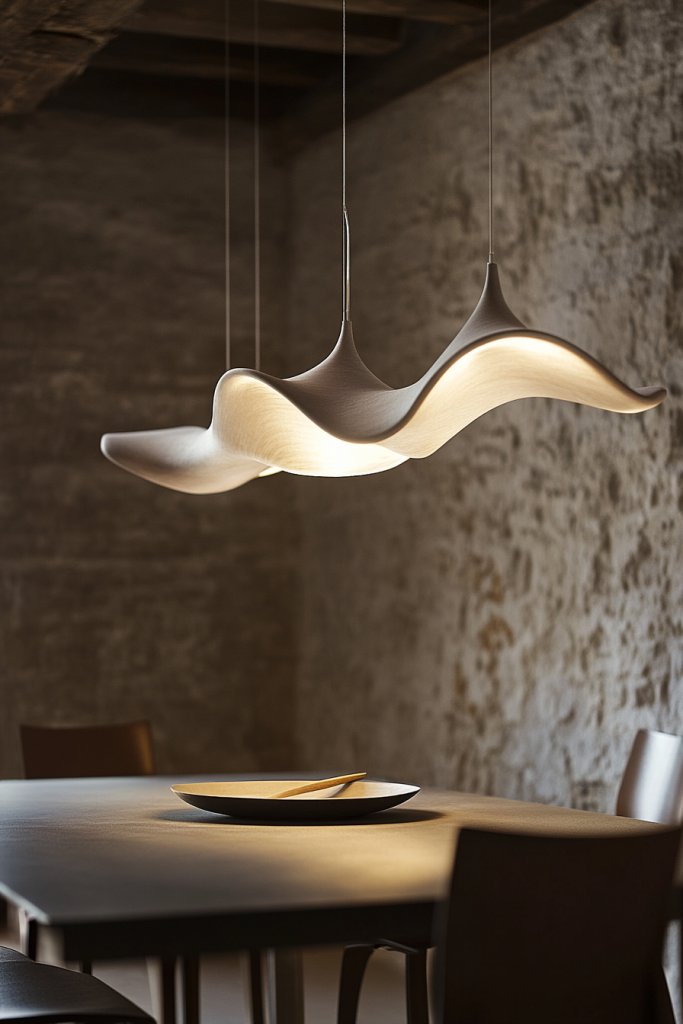
Tired of boring, uniform lighting? Organic-shaped fixtures add an artistic touch and soft, natural illumination to your dining room. They serve as both functional light sources and sculptural focal points, elevating your space’s personality.
Imagine pendant lights with flowing, asymmetrical forms crafted from woven fibers, clay, or metal. Their irregular shapes cast warm, diffused light that mimics natural patterns. Positioned above a simple table, these fixtures create a dynamic visual effect, adding movement and life. The room feels curated, with a hint of handcrafted artistry that draws the eye.
Opt for natural materials like clay, wood, or woven fibers to enhance an organic vibe. Choose fixtures with flowing curves or irregular silhouettes that resemble natural forms like clouds, leaves, or waves. They work well in both minimalist and bohemian settings. Adjust the size and number according to your room’s scale for balance.
Select fixtures with organic shapes that complement your ceiling height and table size. Install with dimmable bulbs to control mood lighting. Use warm-toned bulbs to enhance the natural, cozy feel. Position fixtures at varying heights for visual interest, or cluster several for a statement chandelier effect. Maintain a clean ceiling area to keep the sculptural forms prominent.
Pair with textured wall finishes or subtle accent colors that echo the organic shapes. Incorporate handcrafted or artisanal fixtures for a personal touch. Use dimming controls to adjust ambiance from bright and lively to intimate and relaxed. You could even add decorative elements like woven shades or clay diffusers for extra warmth.
Organic-shaped lighting fixtures break the mold of traditional fixtures and showcase personality and craftsmanship. They turn illumination into art, making your dining room truly unique. With a little creativity, you can craft an environment that feels both inspired and inviting.
8. Built-in Storage with Warm Wood Cabinetry for Functional Elegance
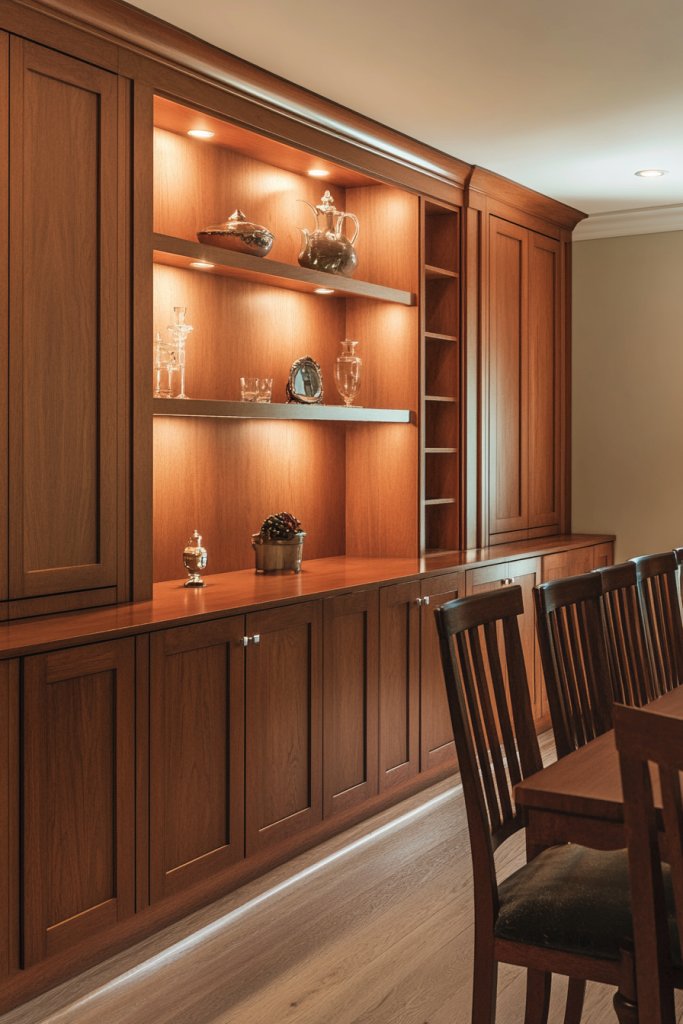
Cluttered spaces can ruin the serenity of an otherwise beautiful dining room. Built-in storage offers a sleek solution that keeps essentials hidden yet accessible. It’s all about combining functionality with elegant design, especially when using warm wood tones.
Visualize seamless wooden cabinets that blend into the walls, with minimalist handles or push-to-open mechanisms. The warm grain of the wood adds richness without overwhelming the space. Open shelves or glass-front cabinets display curated dishes or serveware, adding subtle personality. The overall look is clean, organized, and inviting.
Choose from different wood finishes—light oak for brightness, dark walnut for depth, or painted finishes for a modern twist. Incorporate drawers, pull-out trays, or hidden compartments for maximum utility. For smaller spaces, opt for vertical storage to maximize height. Seasonal or themed decor can be added to open shelves for variety without clutter.
Start with custom cabinetry designed to fit your space and storage needs. Use durable, high-quality wood or veneer for longevity. Incorporate soft-close hinges and pull-out drawers for ease of use. Position storage units along walls or behind the dining area for a seamless look. Finish with a protective coating to preserve the wood’s natural beauty and ease cleaning.
Add personal touches with handcrafted knobs or handles, or incorporate LED lighting inside cabinets for visibility. Use woven baskets or fabric-lined drawers for organization. Mix open and closed storage to display favorite pieces and hide clutter. Personalize the look with painted accents or decorative trims.
Built-in cabinetry turns functional storage into a design feature, elevating your dining room’s style. It’s a smart investment that keeps your space tidy and showcases craftsmanship. With the right choices, your dining area becomes both practical and elegant, inspiring confidence in your design skills.
9. Incorporating Natural Fiber Textiles for Soft Accents
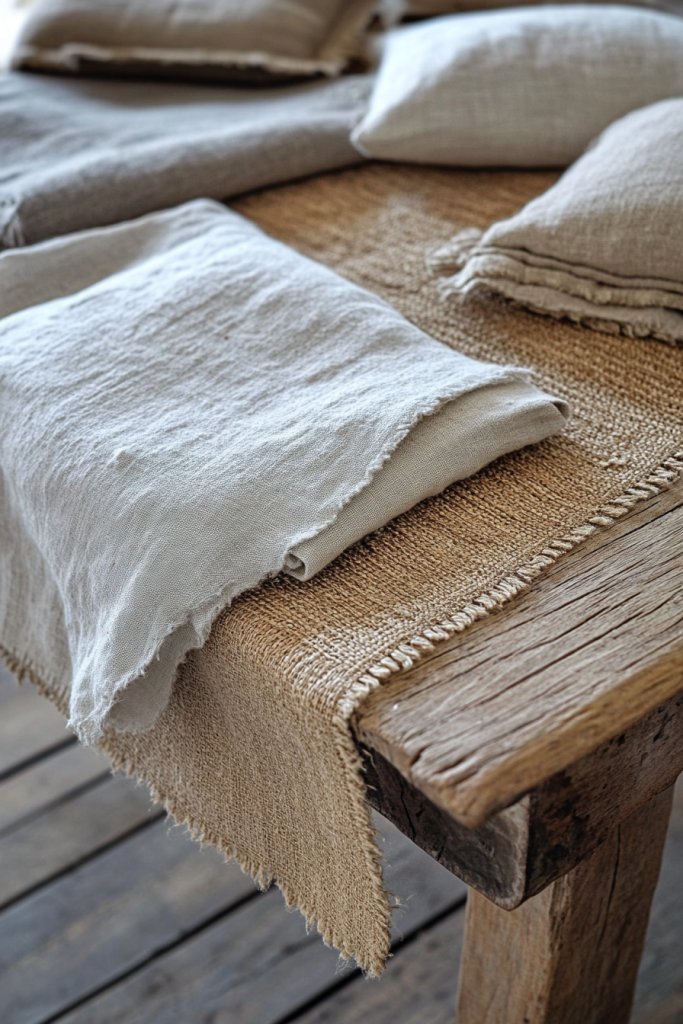
Looking to add warmth and softness without cluttering your organic modern dining space? Natural fiber textiles like linen, jute, and hemp are perfect for creating gentle, eco-friendly accents. They soften hard surfaces and introduce tactile comfort effortlessly.
Picture linen or hemp table runners in muted tones layered over a wooden table, complemented by jute or braided rugs beneath the dining area. Cushions or seat pads made of natural fibers add coziness and a rustic charm. The textures evoke a sense of craftsmanship and sustainability, enriching the room’s organic vibe.
Mix different fibers and weaves for visual interest—think of a jute rug paired with linen napkins. Use natural fiber curtains or woven blinds to soften the windows. Seasonal swaps, like adding heavier wool or lighter cotton, allow flexibility. Incorporate handcrafted or artisanal textiles for a personal, authentic touch.
Choose textiles in earthy or neutral tones to keep the look cohesive. Use woven or braided techniques for rugs and cushions. Secure table runners with simple knots or slips, and attach cushions with fabric ties for stability. Regularly clean and rotate textiles to keep them fresh and vibrant. Select durable, eco-friendly fabrics for longevity.
Add decorative trims or embroidery to personalize textiles further. Use a mix of textures in your cushions—smooth linen with chunky knit accents. Incorporate small handcrafted details like beaded or tasseled edges. Layering different textiles can also create a cozy, layered look that invites touch.
Natural fiber textiles fuse sustainability with style, making your dining space more inviting. They encourage a lifestyle rooted in simplicity and eco-conscious choices. With these natural accents, your room becomes a warm, tactile haven for memorable gatherings.
10. Open Shelving with Handcrafted Dishware for Personal Charm
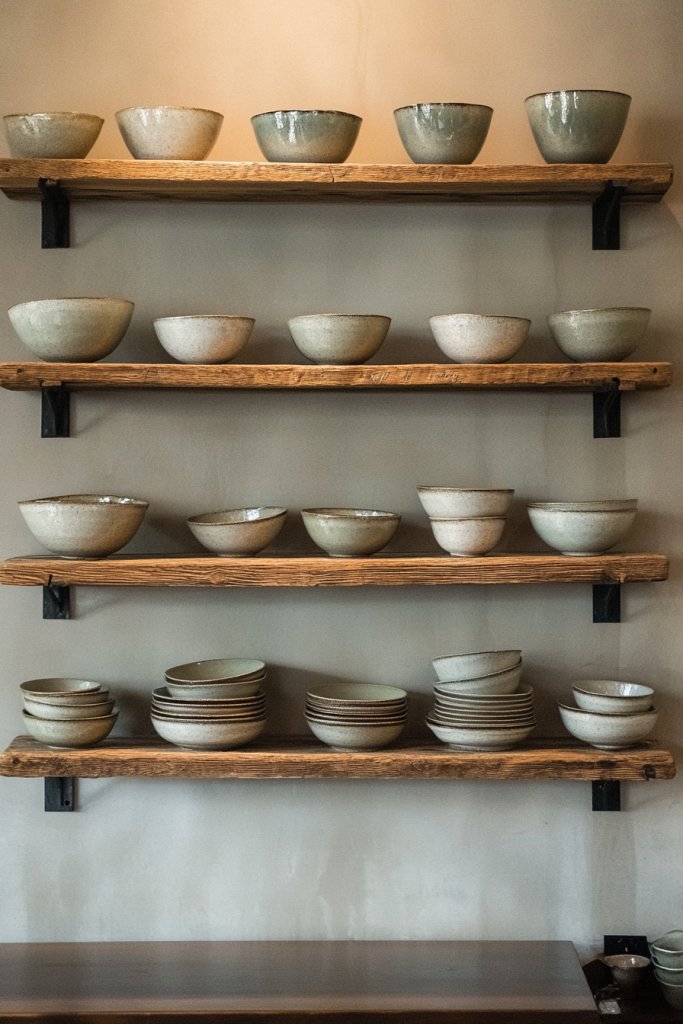
Do your dining space and storage feel disconnected? Open shelving combined with handcrafted dishware brings personality and practicality together. It’s a way to showcase your favorite pieces and keep essentials within reach, all while adding a personal touch.
Visualize floating wooden shelves displaying artisanal ceramics, hand-thrown pottery, or vintage-inspired dishware. The open display creates an inviting, lived-in vibe that invites conversation. The textures and irregularities of handcrafted pieces add visual interest, contrasting beautifully with sleek, modern furniture. Soft lighting highlights each piece, creating a gallery-like atmosphere.
Mix and match different styles and colors for a curated look or keep it uniform for a minimalist feel. Incorporate a few statement pieces amid simpler designs for balance. Use open shelving in smaller nooks or along full walls to maximize visual impact. Seasonal or thematic displays can keep the space fresh and engaging.
Install sturdy, visually appealing wooden or metal brackets, ensuring they can handle weight. Choose handcrafted dishware with textured glazes or unique shapes to add authenticity. Group similar items for cohesion or spread out contrasting pieces for an eclectic look. Keep frequently used items at eye level for convenience. Regularly clean and organize for a tidy presentation.
Personalize with handcrafted or personalized dishware, such as monogrammed plates or colorful glazed bowls. Incorporate decorative elements like woven baskets or fabric liners on the shelves. Rotate or update displays seasonally to keep the aesthetic lively. Add small, sculptural accents or handcrafted containers to complement the dishware.
Open shelving with handcrafted dishware showcases your personality and taste, making your space feel warm and welcoming. It turns everyday dining into an artful experience. With a little effort, you’ll create a charming display that sparks joy and conversation at every meal.
11. Greenery-Free Focus on Textural and Material Variations

Think greenery is the only way to add life to your organic modern dining room? Think again. Focusing on textures and materials can create visual interest and warmth without relying on plants. It’s perfect for those who prefer a minimalist or allergy-friendly environment.
Imagine walls layered with textured plaster, lime wash finishes, or subtly patterned paints that add depth. The table is adorned with matte ceramics, woven baskets, and smooth wooden surfaces. Different finishes—gloss, matte, natural—play with light and shadow, creating a dynamic, tactile space. The room feels alive through its diverse textures rather than a single element like greenery.
Combine matte ceramics with glossy finishes or rough linen with sleek metal. Use textured wall finishes or decorative plaster to add warmth. Incorporate tactile accessories like woven placemats, carved wood, or knotted textiles. Seasonal changes can include adding metallic accents or switching out textiles for different textures.
Select a variety of textured materials in a cohesive color palette. Use matte glazes, textured paints, and natural fibers to add layers. Incorporate tactile decor like carved wooden bowls or woven baskets. Keep surfaces clean and uncluttered, allowing textures to shine. Use lighting strategically to emphasize the material differences.
Personalize by choosing handcrafted or artisanal pieces that emphasize texture. Add decorative elements like textured wall panels or fabric-wrapped furniture. Mix matte and gloss finishes in accessories for visual depth. Incorporate custom-made or vintage items to add character.
Focusing on textures and materials proves that you don’t need greenery to create a lush, inviting space. It’s a celebration of craftsmanship and natural finishes. Your dining room becomes a sensory experience, inspiring confidence in your unique style choices.
12. Incorporating Reclaimed and Sustainable Materials for Eco-Friendly Style

Want your dining room to look good and do good? Reclaimed and sustainable materials are the way to go. They add character, reduce environmental impact, and align with an eco-conscious lifestyle. Plus, they often come with a story that makes your space truly unique.
Visualize a dining table made from reclaimed wood, its surface full of knots and imperfections that speak of history. The chairs might be vintage finds restored with eco-friendly finishes. Incorporate recycled metal accents or glass in light fixtures and accessories. The overall look is rugged yet refined, rich in texture and history, telling a story of sustainability.
Mix reclaimed wood with modern metals for a balanced aesthetic. Use sustainable fabrics for cushions or table runners—think hemp, organic cotton, or recycled polyester. This style suits industrial, rustic, or modern organic designs, adaptable to different tastes. Seasonal accents like natural fiber textiles or vintage pieces refresh the look.
Source reclaimed or sustainably produced materials from reputable vendors. Opt for furniture with certified eco-labels, or repurpose existing pieces with eco-friendly finishes. Incorporate recycled glass or metal for decor or lighting. Be mindful of the origins and treatment of each piece to ensure sustainability. Maintain with non-toxic cleaning products to preserve eco-credentials.
Personalize with handcrafted, upcycled decor items or vintage finds that tell a story. Use natural dyes or finishes to enhance the character of reclaimed pieces. Mix in modern elements to keep the space fresh. Highlight the eco aspect with signage or labels that share the story of each piece.
Choosing reclaimed and sustainable materials demonstrates style and ethics. It’s a statement that your design values the planet. With a bit of effort, you can craft a beautiful, responsible space that inspires pride and conscious living.
13. Layered Lighting with Dimmers for Mood Control
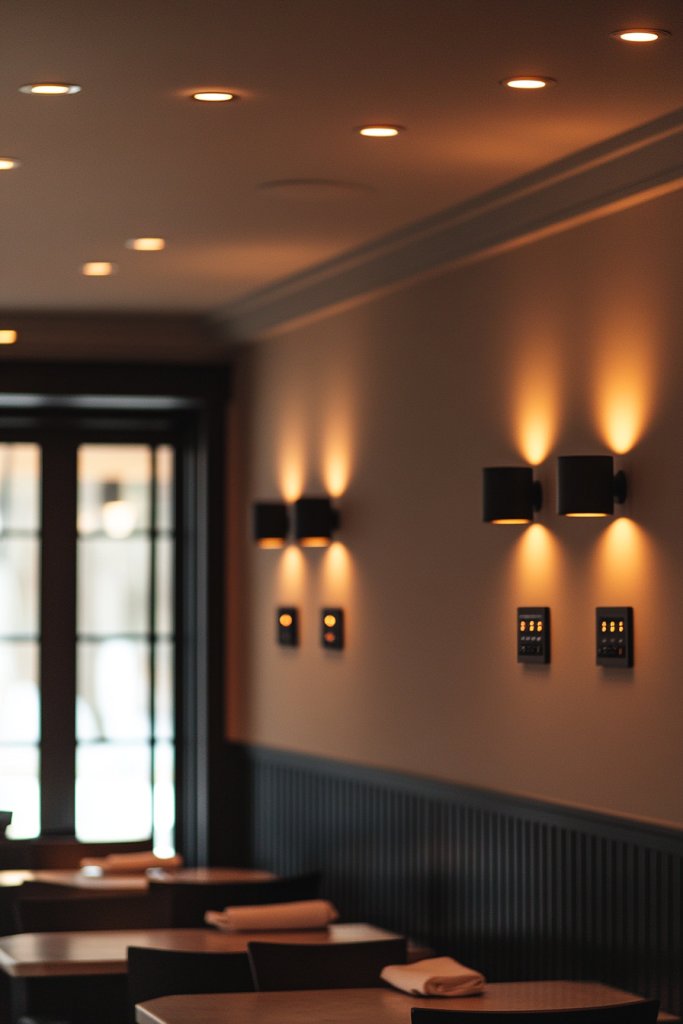
Ever felt like your dining room lighting is either too harsh or too dull? Layered lighting with dimmers solves this dilemma, giving you full control over the ambiance. It allows your space to transition from lively dinners to intimate gatherings seamlessly.
Picture a room with a combination of recessed ceiling lights, wall sconces, and a central fixture—each layer adjustable with dimmers. During dinner, bright lighting highlights the table and conversation. As the night progresses, dim the lights for a cozy, relaxed atmosphere. Soft shadows and warm glows create an inviting environment that adapts to your mood.
Use warm-toned bulbs for a cozy feel or cooler hues for a modern, energetic vibe. Incorporate fixtures like sconces, LED strips, or cove lighting for layered effects. For a more dramatic look, combine uplights and downlights with adjustable settings. This flexibility makes it suitable for all seasons and occasions.
Install dimmable switches compatible with your existing lighting fixtures. Use high-quality dimmable bulbs to ensure smooth operation. Layer lighting sources—ambient, task, and accent—to achieve the desired effect. Position fixtures thoughtfully for balanced illumination without glare. Regularly adjust and fine-tune settings to match different activities or moods.
Add decorative fixtures with organic shapes or textured finishes to complement your style. Use smart lighting systems for remote control and scene setting. Incorporate adjustable sconces or bedside lamps for additional flexibility. Personalize your lighting scenes for holidays, dinners, or quiet nights.
Layered lighting with dimmers transforms your dining experience into an artful dance of light and shadow. It’s a simple upgrade that dramatically improves mood and functionality. With the right setup, your space becomes adaptable, stylish, and effortlessly inviting.
14. Custom Built-In Benches for Seamless Seating and Flexibility
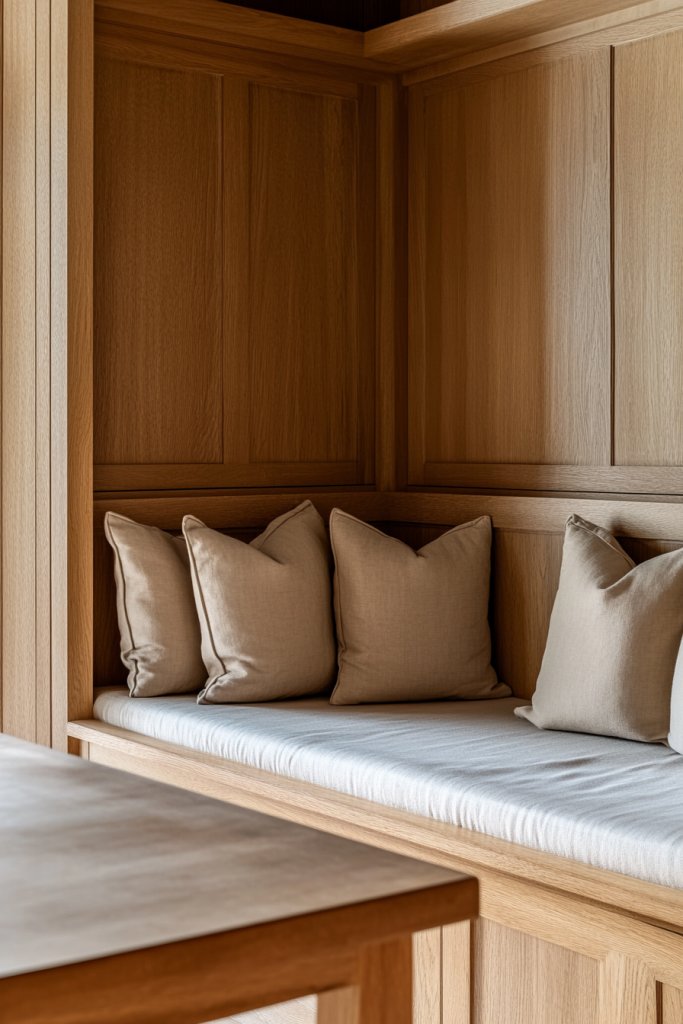
Are bulky chairs taking up too much space or making your dining room feel cramped? Custom built-in benches offer a sleek, space-saving alternative that maximizes flexibility. They create a cohesive look and can be tailored to fit your exact needs.
Imagine a long, wooden bench built into the wall, upholstered with a neutral fabric that matches the room’s organic vibe. The bench runs along the length of the wall, offering ample seating without cluttering the room. Its clean lines and integrated design make the space feel streamlined and intentional. The simplicity of the built-in encourages a relaxed, communal atmosphere.
Use natural woods or painted finishes to match your decor style. Incorporate hidden storage beneath the seating surface for practicality. Extend the bench around the corner or under windows for a cozy nook. Combine with scatter cushions or throws for added comfort and color. This setup is versatile for both casual and formal dining.
Start by measuring your space carefully and designing a bench that fits snugly against walls or under windows. Use sturdy framing and high-quality materials to ensure durability. Attach the bench securely to the wall for safety. Upholster with durable, easy-to-clean fabrics or natural fibers. Finish with trim or molding to integrate it seamlessly into the room.
Customize with decorative cushions in textures and colors that reflect your personality. Incorporate built-in planters or shelf accents above the bench for added interest (avoiding actual greenery to stay compliant). Add subtle lighting underneath or along the edge for ambiance. Personal touches make the space inviting and functional.
Built-in benches combine style with practicality, making your dining room more inviting and versatile. They encourage a communal, relaxed dining experience and showcase thoughtful design. With a little planning, you can create a sleek, personalized seating area that lasts for years.
15. Artful Use of Textured Wall Finishes for Subtle Visual Interest

Are your walls feeling flat and uninspiring? Textured finishes add depth and warmth without overwhelming the space. They create a subtle visual complexity that elevates your organic modern dining room, making it more inviting and sophisticated.
Picture walls coated with lime wash, textured plaster, or subtle stucco finishes that catch the light differently throughout the day. These surfaces add tactile richness, inviting touch and curiosity. The textures contrast beautifully with smooth wooden tables and soft textiles, creating a layered environment. Warm, ambient lighting accentuates these finishes, emphasizing their depth.
Choose from various textures—rough, smooth, or patterned—to suit your aesthetic. Combine matte or subtle gloss finishes for extra dimension. Experiment with techniques like troweled plaster, Venetian plaster, or lime wash to find your signature look. These finishes work well in both small and large spaces, adding sophistication without clutter.
Start with a primer and high-quality textured finishing products suitable for interior walls. Use trowels, sponges, or brushes to create patterns or effects. Consider hiring a professional for complex techniques, or DIY with tutorials for simpler finishes. Seal the surface with a matte or satin topcoat to enhance durability. Pair with minimal decor to let the textures stand out.
Add personalized touches with decorative trims or custom patterns. Incorporate subtle color variations or metallic accents within the finish for uniqueness. Use lighting to cast shadows that highlight the textures. Keep the overall decor minimal to let the textured walls be the star.
Textured wall finishes add a layer of artistry and craftsmanship to your space. They create a warm, layered environment that feels both timeless and modern. With a bit of effort, you can craft walls that are full of personality and subtle visual intrigue.
16. Monochromatic Scheme with Variations in Material and Finish
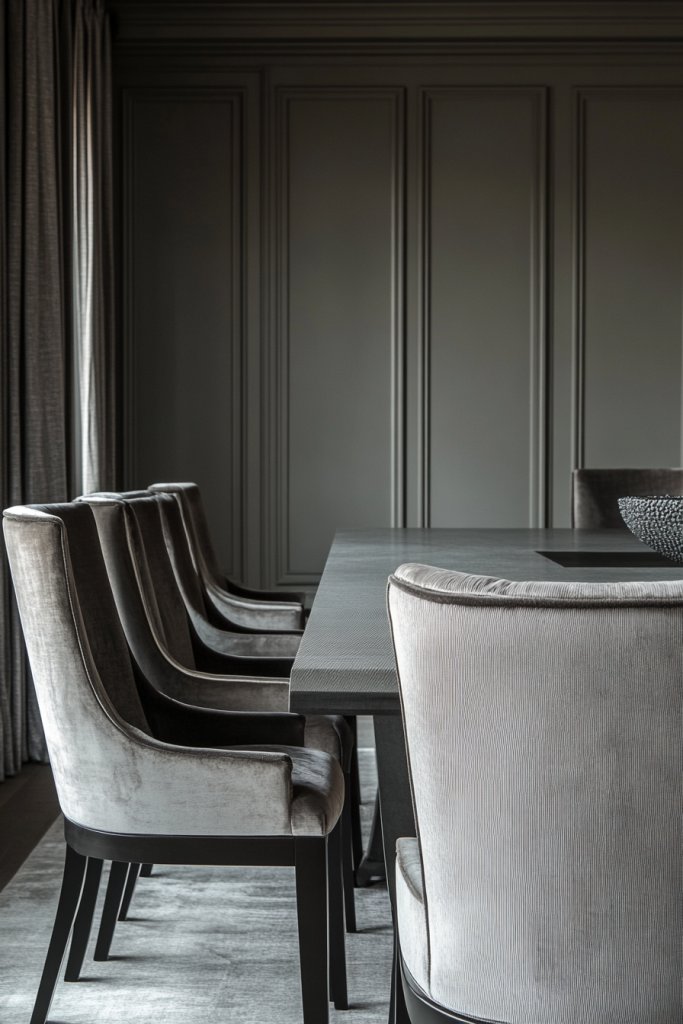
Want a sophisticated look that feels cohesive and calming? A monochromatic color scheme with varied materials and finishes can do just that. It creates visual interest without chaos, making your dining room elegant and harmonious.
Imagine a space with shades of soft gray or warm taupe, layered through different textures: matte ceramics, glossy metal accents, natural wood, and plush textiles. The room feels unified yet dynamic, with light playing differently on each surface. The consistent palette ties all elements together into a seamless, refined environment.
Use different finishes—matte, gloss, satin—within the same color family to add depth. Incorporate various materials like leather, velvet, or woven fibers for variety. This scheme adapts easily across styles, from minimalist to bohemian. Seasonal updates can include adding metallic or reflective accents for a fresh look.
Select a dominant color and build your palette around it. Choose furniture, textiles, and decor in different finishes, ensuring they complement rather than clash. Use layered lighting to highlight the material differences and add depth. Keep accessories minimal but textured to maintain interest. Consistency is key for a balanced look.
Add subtle pops of a slightly different shade within the same color family for visual interest. Incorporate handcrafted or artisanal pieces with unique finishes. Use textiles like throws or cushions to introduce tactile variation. Personalize the scheme with curated collections that reflect your style.
A monochromatic scheme with material variation exemplifies elegance through simplicity. It’s perfect for creating a calm, sophisticated dining environment. This approach encourages confidence in choosing quality materials and finishes that stand the test of time.
17. Incorporating Artisanal Craftsmanship for Unique, Handcrafted Details
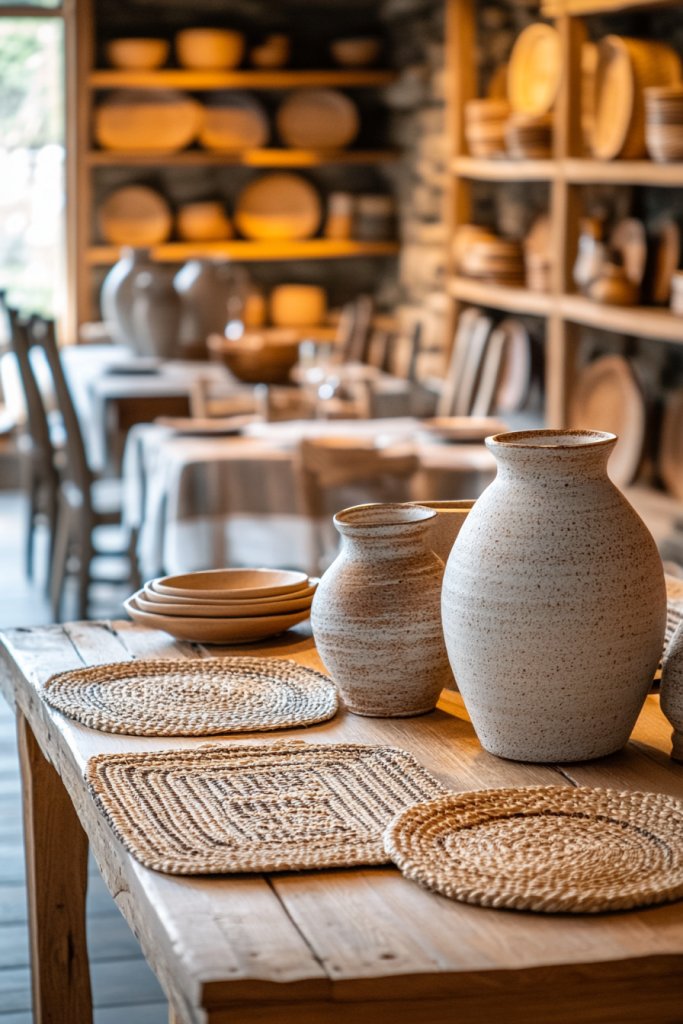
Tired of mass-produced decor that feels impersonal? Incorporating artisanal craftsmanship introduces personality and authenticity into your dining room. Handcrafted details showcase skill and passion, making your space truly one-of-a-kind.
Visualize a dining table with a handcrafted wood base, its surface showing brush strokes or subtle imperfections that highlight artistry. The lighting fixtures are sculptural, made from woven fibers or clay, emphasizing natural, organic forms. Artisanal ceramics, textiles, or furniture pieces add layers of character and tell a story of craftsmanship.
Mix artisanal pieces with modern furniture for a balanced look. Use handcrafted tableware, woven baskets, or sculptural lighting to add focal points. Incorporate local or cultural motifs for a personal touch. This approach suits both rustic and contemporary styles, adding depth and warmth.
Source handcrafted items from local artisans or craft markets. Prioritize quality and uniqueness over mass production. Use natural or eco-friendly finishes to preserve authenticity. Mix and match different crafts—woodwork, ceramics, textiles—for a curated, eclectic vibe. Regularly update or rotate pieces to keep the space fresh.
Commission custom pieces that reflect your personality or heritage. Incorporate handcrafted artwork or decorative objects that resonate with you. Use artisanal textiles for cushions or table runners. Personal touches make your dining space not just stylish but meaningful.
Artisanal craftsmanship elevates your decor from generic to extraordinary. It supports local artists and promotes sustainable practices. With a curated collection of handcrafted pieces, your dining room becomes a reflection of your values and style, inspiring pride and admiration.
Conclusion
The diverse ideas showcased in this article demonstrate how organic modern dining rooms can be both stylish and welcoming. By incorporating elements like natural textures, warm tones, and greenery, you can craft a space perfect for elegant gatherings. Don’t hesitate to try these-inspired touches in your own home and create a dining environment that exudes comfort and sophistication. Embrace the beauty of nature and let your dining room become a sanctuary of style and warmth!